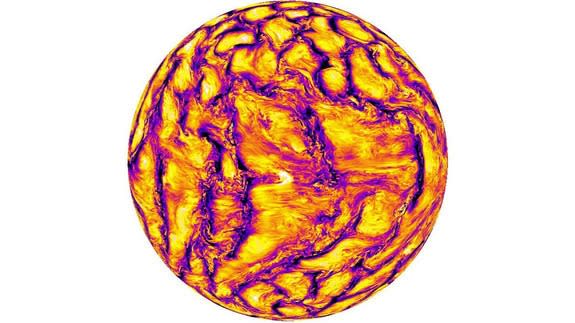Dive below the sun's surface with this new model of our closest star

Scientists have advanced in their quest to create an accurate model of the sun's inner workings, which could pave the way to a better understanding of our solar system.
Accurate solar models might help researchers figure out how our star affects the planets of the solar system, and warn of impending solar storms that could affect Earth as well.
A new study in the journal Science details a model that reconciles both the small-scale magnetic field features of the sun with the larger-scale features in high resolution, one of the first steps on the long road toward making an accurate computer model of our sun.
SEE ALSO: NASA video of swirling magnetic arches on the sun is completely mesmerizing
As the study shows, modeling the sun isn't easy.
The star is an incredibly complex system of interwoven magnetic fields that are difficult to re-create using even the most advanced supercomputers.
The new simulation mimics the state of the sun's magnetic fields at about 200,000 kilometers, or 124,000 miles, below the star's visible surface, in what is known as the convection zone.
The magnetic fields of the sun itself appear to be created by a dynamo — a natural electric generator on a massive scale — produced by rotating, electrically conductive material in the star, though the exact nature of the dynamo is still mysterious.
The convection zone
The convection zone is a chaotic region of charged particles that are boiling within the star.

Image: GIPHY
"On the most basic level, it's kind of like a pot of boiling water, it's just that you don't have water, you have a gas. But in addition to that, the gas is so hot that it's actually ionized, which essentially means that you can have electric currents flowing in the system," Matthias Rempel, co-author of the study, told Mashable.
"If that is happening, then essentially the boiling motions in this gas, they actually can change these electric currents and they can also change the magnetic field which is present in the convection zone."
Cooler gas moves down within this zone, while warmer gas moves up, but the fact that the zone can conduct electricity makes it all the more complicated to model, Rempel added.
Rempel and the research team were able to change the diffusivity — the rate at which particles can spread — of the convection zone to reproduce the relatively small, chaotic magnetic field process while also simulating the larger-scale magnetic field changes at the same time.
The team decreased the diffusivity of the smaller scale magnetic features, which initially made the magnetic effect at a large-scale disappear, Rempel said.
However, as Rempel and his colleagues pushed on, they found that if they further decreased the diffusivity, then the large fields came back, reproducing the broad strokes of the sun's physics.
"Our numerical models have always had a problem that you get to pick which part you want to look at," NASA Solar Dynamics Observatory project scientist Dean Pesnell, who was unaffiliated with the study, told Mashable.

Image: Hideyuki Hotta, Chiba University
"I can either look at the really big stuff, or I can make models that are kind of like microscopes — one single sunspot. It has been very difficult to make models that can give you the resolution of that sunspot model around the entire sun. So, that's what they [Rempel and the research team] are trying to work on," he said.
It took about 30 million processor hours of supercomputing time, split between two supercomputers, to create the new model.
Why modeling matters
Scientists want to create accurate representations of the sun for a variety of reasons.
These kinds of models can be used to help researchers learn more about how the sun affects the planets of the solar system, Pesnell said.
For instance, Mars likely lost its atmosphere to space because of the solar wind battering the small planet, so being able to run a specific model of the star could shed some light on how exactly that happened.
Scientists also hope to eventually use modeling to be able to predict the appearance of sunspots during its solar cycle. That kind of prediction could help infer when the sun will burp out coronal mass ejections — bursts of hot plasma that fly off into the solar system — which can impact Earth and even disrupt power grids.
The sun's radiation can also alter the orbits of satellites circling the planet. More refined modeling will make it easier to anticipate when a spacecraft could be in danger of falling out of orbit during an active solar cycle.
"Understanding what the sun is doing, and predicting what it's going to do 10, 20 years from now is a major goal for NASA because we run missions that last 10, 20 years," Pesnell said.

